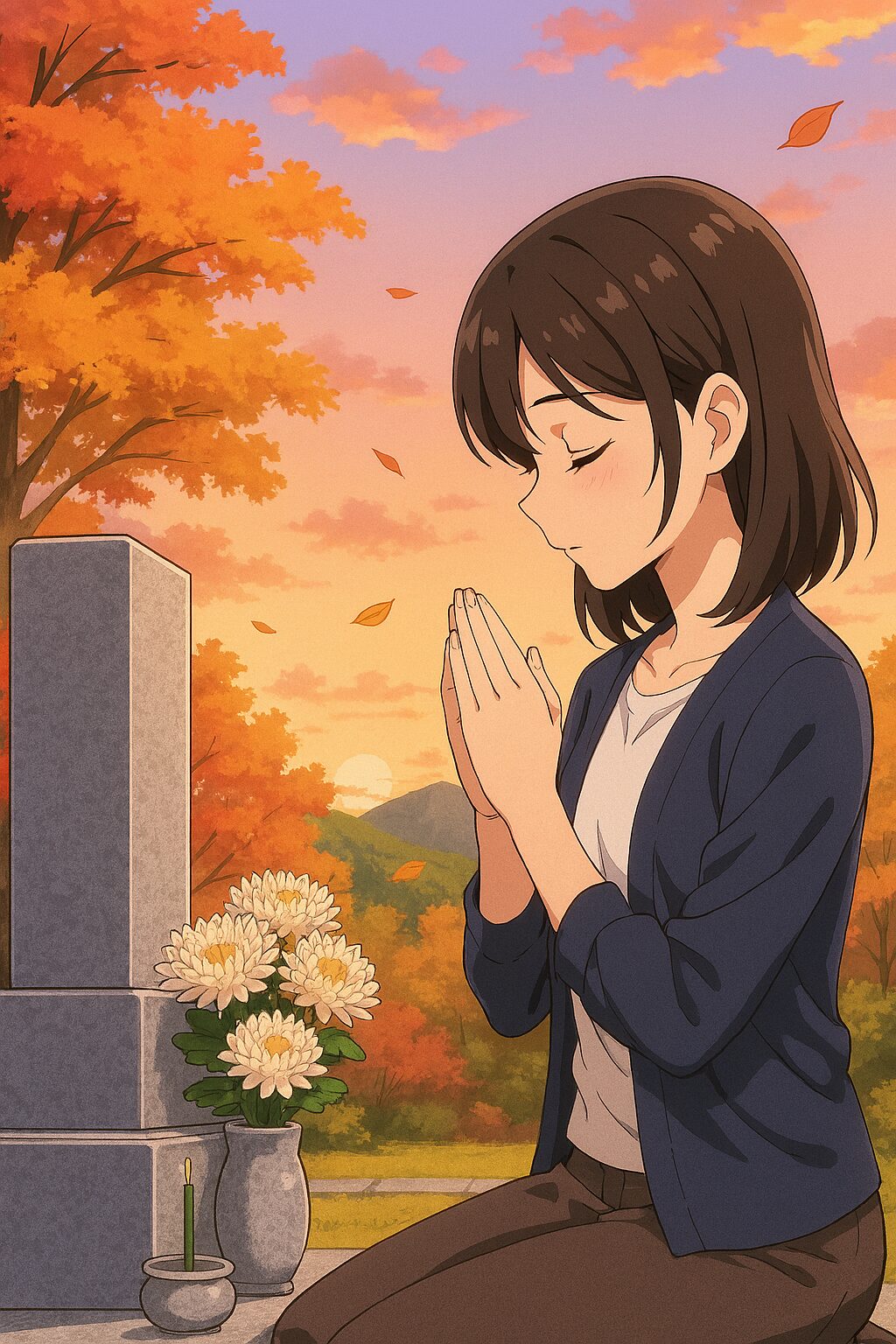A gentle celebration of balance, remembrance, and spiritual heritage in Japanese culture.
- What Is Autumnal Equinox Day?
- The Astronomical Meaning
- A Buddhist Tradition: The Middle of Higan
- Its Original Form: A State Ritual Called Shūki Kōreisai
- Ancestor Worship: A Tradition Older Than Buddhism
- How Japanese People Spend the Day
- For International Readers: A Holiday of Stillness and Spirit
- Conclusion: A Day to Honor Nature and Ancestors
- はじめに:秋分の日って何?
- 秋分の日の天文学的な意味
- 秋分の日は「彼岸の中日」
- 本来の秋分の日:秋季皇霊祭という国家儀式
- 祖先をまつる文化は縄文時代から続いている
- 秋分の日の過ごし方:現代の日本人はどうしている?
- 海外の読者へ:日本人の「静かな祝日」の意味
- まとめ:秋分の日は「自然と祖先を敬う日」
What Is Autumnal Equinox Day?
Every year around September 23, Japan observes a national holiday called Autumnal Equinox Day. While many Japanese people associate it with Buddhist customs like visiting graves, its origins are far older and deeper.
For international readers, this day may be unfamiliar. In this article, we’ll explore its astronomical meaning, spiritual significance, and cultural roots that stretch back over 10,000 years.
🌐 Reference: What Is Autumnal Equinox Day?|tekowa
The Astronomical Meaning
Autumnal Equinox Day marks the moment when the sun crosses the celestial equator heading south. On this day, the sun rises due east and sets due west, making day and night nearly equal in length.
This balance occurs because of Earth’s axial tilt of approximately 23.4 degrees, which creates the seasons. The equinox is a natural turning point, signaling the arrival of autumn.
Fun fact: Daytime is actually a few minutes longer than nighttime due to atmospheric refraction and the way sunlight lingers even after the sun dips below the horizon.
A Buddhist Tradition: The Middle of Higan
In Japan, Autumnal Equinox Day is the midpoint of a Buddhist observance called Higan, which lasts for seven days. “Higan” means “the other shore,” referring to enlightenment.
During this period, families visit graves, offer flowers and food, and reflect on the lives of their ancestors. One traditional offering is ohagi—sweet rice balls coated in red bean paste. The red color is believed to ward off evil spirits.
Its Original Form: A State Ritual Called Shūki Kōreisai
Before World War II, Autumnal Equinox Day was not just a Buddhist custom—it was a formal state ceremony known as Shūki Kōreisai, or the Autumn Imperial Ancestor Festival.
On this day, the Emperor of Japan would honor the spirits of past emperors and imperial family members in a sacred ritual. It was a national act of ancestral reverence.
After the war, Japan’s constitution separated religion from state, and the holiday was renamed and secularized. But the spirit of remembrance remains strong.
“If the Emperor honors his ancestors, then we, the people, should honor ours too.”
Ancestor Worship: A Tradition Older Than Buddhism
Japanese people have been honoring their ancestors for over 10,000 years—long before Buddhism arrived. In the Jōmon period, people buried their dead with care and created clay figurines (dogū) believed to hold spiritual power.
This deep respect for the dead and for nature is a core part of Japanese identity. Autumnal Equinox Day is a modern echo of these ancient values.
How Japanese People Spend the Day
- 🪦 Grave visits: Families clean tombstones, offer flowers and ohagi, and pray for their ancestors.
- 🏡 Home rituals: Many people light incense and offer food at household altars.
- 🍁 Enjoying nature: The day often marks the start of autumn outings like hiking or leaf viewing.
- 🍽️ Seasonal foods: Chestnut rice, mushrooms, and sweet potatoes are popular dishes.
It’s a quiet, reflective holiday that strengthens family bonds and connects people to the rhythms of nature.
For International Readers: A Holiday of Stillness and Spirit
Unlike Japan’s lively festivals and fireworks, Autumnal Equinox Day is a gentle, introspective celebration. It’s about balance—between light and dark, life and death, past and present.
It’s a day to pause, reflect, and honor those who came before us. In doing so, we also honor ourselves and the world we live in.
🌸 Japanese holidays are not just days off—they’re moments to realign with nature and spirit.
Conclusion: A Day to Honor Nature and Ancestors
Autumnal Equinox Day is more than a seasonal marker. It’s a cultural and spiritual tradition rooted in astronomy, Buddhism, imperial rituals, and prehistoric reverence for the dead.
Though its form has changed over time, its essence remains: gratitude, remembrance, and harmony with the natural world.
This year, take a moment to look up at the sky and quietly thank those who came before you.
Related Links and References
- What Is Autumnal Equinox Day?|tekowa
- Origin and Meaning of Autumnal Equinox Day|Japanese Event Calendar
- Deep Dive into Autumnal Equinox and Higan|amehati.net
- What’s Today’s Special Day? Series|kiri53.com
秋分の日とは?自然と祖先を敬う、日本人の心の祝日
はじめに:秋分の日って何?
毎年9月23日頃、日本では「秋分の日」という祝日が訪れます。日本に住んでいる方でも、「昼と夜の長さが同じになる日」「お墓参りをする日」といった漠然としたイメージしか持っていない方も多いのではないでしょうか。
ましてや、海外の方にとっては「秋分の日」という言葉自体が初耳かもしれません。
この記事では、日本の秋分の日が持つ天文学的な意味、仏教との関わり、そして古代から続く祖先崇拝の文化まで、わかりやすく丁寧にご紹介します。
🌐 外部参考リンク:秋分の日とは?意味と由来をわかりやすく解説|tekowaの食の万華鏡
秋分の日の天文学的な意味
秋分の日は、地球が太陽の周りを公転する軌道上で「秋分点」を通過する日です。この日は、太陽が真東から昇り、真西に沈むため、昼と夜の長さがほぼ同じになります。
これは、地球の自転軸が約23.4度傾いていることによって季節が生まれるためで、春分と秋分はそのバランスが整う特別な日なのです。
実は「昼の方が数分長い」という事実もあります。これは大気による光の屈折や、太陽が完全に沈む前後の光の影響によるものです。
秋分の日は「彼岸の中日」
日本では秋分の日は「秋のお彼岸」の中日にあたります。「彼岸」とは仏教用語で「悟りの世界」を意味し、春と秋にそれぞれ7日間の期間があります。
秋分の日はそのちょうど真ん中の日。この日は多くの家庭でお墓参りをしたり、仏壇に手を合わせたりして、亡くなった人々を偲びます。
🍡 秋分の日には「おはぎ」をお供えする習慣があります。小豆の赤色には魔除けの意味があり、先祖の霊を慰める食べ物として受け継がれてきました。
本来の秋分の日:秋季皇霊祭という国家儀式
現在では仏教行事のように思われがちな秋分の日ですが、戦前の日本では「秋季皇霊祭(しゅうきこうれいさい)」という国家儀式の日でした。
この日は、天皇陛下が歴代天皇や皇族の御霊を宮中で祀る日。つまり、国家として祖先を敬う日だったのです。
戦後の民主化に伴い、宗教的な要素を薄めて「国民の祝日」として再定義されましたが、その精神は今も受け継がれています。
「天皇陛下がお祭りするのなら、国民もご先祖様をお祭りしよう」 そんな考え方が、秋分の日の根底にあるのです。
祖先をまつる文化は縄文時代から続いている
日本人が祖先を敬うという習慣は、実は1万年以上前の縄文時代から続いています。
縄文人は、自然の中に神を見出し、亡くなった人々の魂を大切にする文化を持っていました。土偶や埋葬の儀式などからも、死者への敬意がうかがえます。
秋分の日は、そんな日本人の精神文化が現代にも息づいていることを示す日でもあるのです。
秋分の日の過ごし方:現代の日本人はどうしている?
現代の日本では、秋分の日は以下のような形で過ごされています:
- 🪦 お墓参り:家族で墓地を訪れ、花やおはぎを供えて手を合わせる
- 🏡 仏壇供養:自宅で仏壇に手を合わせ、故人を偲ぶ
- 🍁 自然とのふれあい:秋の行楽シーズンにあたり、紅葉狩りやハイキングを楽しむ
- 🍽️ 旬の食材を味わう:栗ご飯、きのこ料理、さつまいもなど秋の味覚を楽しむ
秋分の日は、家族の絆を再確認する日でもあります。
海外の読者へ:日本人の「静かな祝日」の意味
日本の祝日というと、にぎやかな祭りや花火大会を思い浮かべる方も多いかもしれません。しかし、秋分の日はその対極にある「静かな祝日」です。
自然のバランスが整う日、祖先に感謝する日、そして心を整える日。
このような祝日があることは、日本人の精神文化の深さを物語っています。
🌸 日本の祝日は、単なる休日ではなく「心を整える時間」でもあるのです。
まとめ:秋分の日は「自然と祖先を敬う日」
秋分の日は、昼と夜の長さがほぼ同じになる天文学的な節目であり、同時に祖先への感謝と自然への敬意を表す、日本独自の精神文化が息づく祝日です。
戦前の国家儀式「秋季皇霊祭」から、戦後の「国民の祝日」へと形を変えながらも、根底にある「敬う心」は変わっていません。
そしてその心は、縄文時代から1万年以上続く、日本人の魂の記憶でもあります。
今年の秋分の日は、ぜひ静かに空を見上げ、ご先祖様に思いを馳せてみてください。



コメント